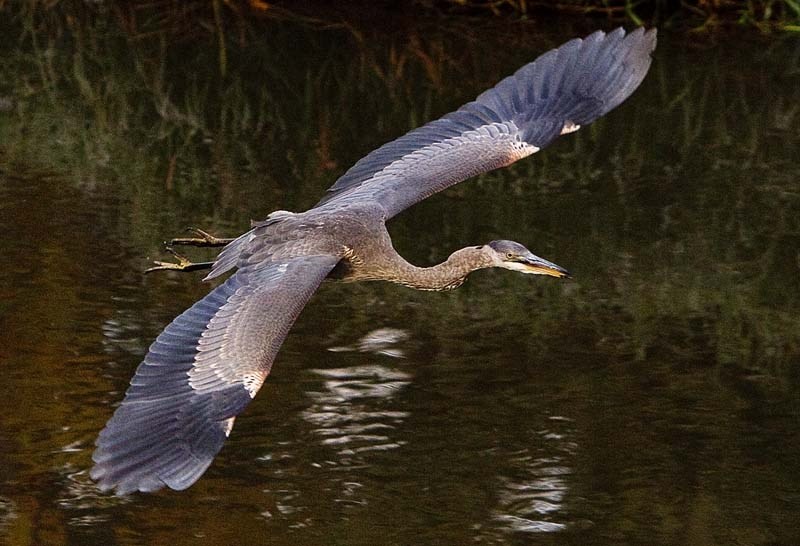Patience always pays off when it comes to birds.
I was cruising along the Red Willow Trail near Ray Gibbon Drive a while back when a passerby pointed out a great blue heron standing in the middle of the Sturgeon River. It was still as a statue, facing the wind, pointing west with its beak, neck held steady at a roughly 45-degree angle to the water. There was an intensity about it, as if it were waiting for something. I decided to wait too.
After what seemed like an eternity, the bird sprang into action, stabbing at something in the water with a splash. It missed! It leapt a short distance with its huge, powerful wings, jabbed a few more times, and came back up with a fish that seemed bigger than its head. With the fish impaled on its beak, it waded to the opposite shore, swiftly flipped the fish around and gobbled it headfirst, its throat stretching to almost double its width as it swallowed.
It looked rather satisfied with itself.
The great blue heron is easily one of the biggest birds you'll see around the Sturgeon. At up to 1.4 metres tall with an even bigger wingspan, they're the biggest herons in North America, reports the Cornell Lab of Ornithology.
Look for grey-blue feathers, long legs, an even longer neck, and a long straight beak, says local birder Peter Demulder. The head should also have a black cap with black feathers trailing from it.
"When they're standing still, they look statuesque," he said.
In flight, which is usually preceded by a guttural squawk, the great blue heron moves with slow, majestic beats of its wings. Unlike cranes, these birds will curl their necks back to rest their heads on their shoulders in flight instead of holding them straight.
Great blue herons are usually seen near shallow waters or marshes like Big Lake, says Hugh Wollis, a St. Albert resident and a retired wildlife biologist with Alberta Fish and Wildlife.
They're typically very quiet, notes Hinterland Who's Who, but are known to make some entertaining sounds under certain circumstances. Expect a "frawnk" if they're spooked while at home, a "gooo" during courtship, an "ee" while flying, and a "roh-roh-roh" when they're approaching their nests. They are also known to snap their bills loudly during courtship, and to tap the sides of their beaks together once they've hooked up.
When competing for a mate, these birds may perform elaborate "bill duels" in which they'll thrust their beaks at each other, hoping to grab their opponent's neck, notes Hinterland Who's Who. You might also see them defend their feeding grounds by approaching intruders with their heads thrown back, wings outstretched and bill pointed skywards, the Cornell Lab reports.
Patience
Great blue herons are very patient hunters and are known to stand perfectly still for up to 10 minutes as they wait for an unsuspecting fish, frog, bug or mouse to wander by, Demulder notes.
When they spot something edible with their big eyes, they flash their neck out like a snake, using their huge beak to either stab or grab their prey. Fish are then flipped around to be swallowed whole and headfirst.
"You can see the bulge as it goes down."
Great blue herons may whack a really big fish against the ground a few times in order to tenderize it, Demulder says. Some get too greedy and choke to death on their lunch, Wollis adds.
While great blue herons hunt alone (and are quite territorial about their hunting grounds), Wollis says, they tend to nest in colonies, often putting several of their gigantic nests in the same tree.
"It's like an apartment building."
This can be a problem, he notes, as the prodigious amount of feces they create tends to kill those same trees.
"They destroy their own habitat over the years."
Great blue herons often reuse their nests year after year, Wollis says, so it's important to protect their nesting sites. Stay away from nests if you see them, he suggests, and protect wetlands where possible.
And if you do see one standing in the middle of the Sturgeon, just keep quiet and be patient – you'll soon be in for quite a show.
Great blue heron
Name:
Ardea herodias.
Appearance:
Large metre-tall bird with blue-grey feathers, huge wingspan, long neck, long legs and dagger-like beak.
Commonly seen:
Standing very still in the shallows of the Sturgeon River.
Occasionally confused with:
The black-crowned night heron, which has a much smaller neck.
Fun fact:
It is the official mascot of the Big Lake Environment Support Society.
Wild St. Albert
Like wildlife? So do we! Every second Wednesday the Gazette profiles a reasonably common wild creature in the St. Albert region. Birds, beasts, bugs, fish … so long as it's alive and kicking, we'll feature it.
Got a creature you'd like to see profiled? Send your suggestions to [email protected].




